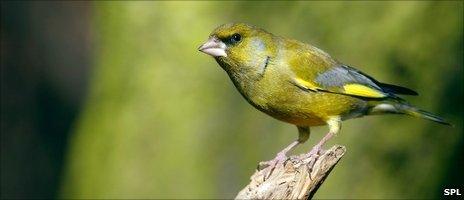Disease threat to UK garden birds
- Published

The disease has caused a decline in the breeding population of greenfinches
A disease that first emerged in the UK in 2005 has caused a severe decline in the number of greenfinches and chaffinches, according to researchers.
In the worst affected areas, greenfinch populations have fallen by an estimated 35% and in 2007 about 500,000 birds of all species were killed, they say.
The British Trust for Ornithology (BTO) has blamed a fatal infection caused by the parasite Trichomonas gallinae.
It said the number of deaths from such an emerging disease was unprecedented.
Findings about the "disease" are reported in the journal PLoS One.
The impact on birds has been estimated from a "citizen science" project in which more than 700 people have been monitoring bird numbers in their gardens since 2003.
The "Garden Bird Health Initiative" involved scientists from the BTO and other conservation organisations analysing population trends of several common garden birds.
Mike Toms, who is from the BTO and a co-author of the study, told BBC News: "It's really the first time we've seen this level of mortality from a new and emerging disease within birds in Britain."

Researchers are urging people to clean garden bird baths and bird feeders "regularly"
The disease has caused a decline in the populations of both chaffinches and greenfinches, but it seems to impact particularly upon the greenfinches.
"Something makes [greenfinches] more susceptible," Mr Toms said.
"It could be because there are more of these birds gathering together. They tend to be seen in groups around bird tables, so there could be greater transmission."
He said the trichomonad parasite harbouring the disease was probably transmitted via birds' saliva.
"If a bird regurgitates something it can't swallow [or] if it takes a drink at a bird bath, that is a potential route of transmission," Mr Toms explained.
"Keeping things clean" could effectively break this cycle, so the researchers are urging bird-lovers to clean bird feeders and bird baths in their gardens at least once a week.
"People will be able to notice [signs of the disease]," Mr Toms said. "They might see birds in their gardens that are fluffed up, lethargic and they might look a bit wet around the bill."
The researchers do not yet know the original source of the infection but its emergence and spread has coincided with an increase in the population of wood pigeons.
Mr Toms said: "It's possible that it came into British gardens through wood pigeons and jumped across species into the finches."
Veterinary researchers involved in the initiative are currently studying the DNA of the disease to find out where exactly it came from.
"You find with new diseases... at the beginning you get a large number of the birds dying off then you get the development of some resistance," said Mr Toms.
"We will be able to look over the next two to three years and see if populations start to recover."